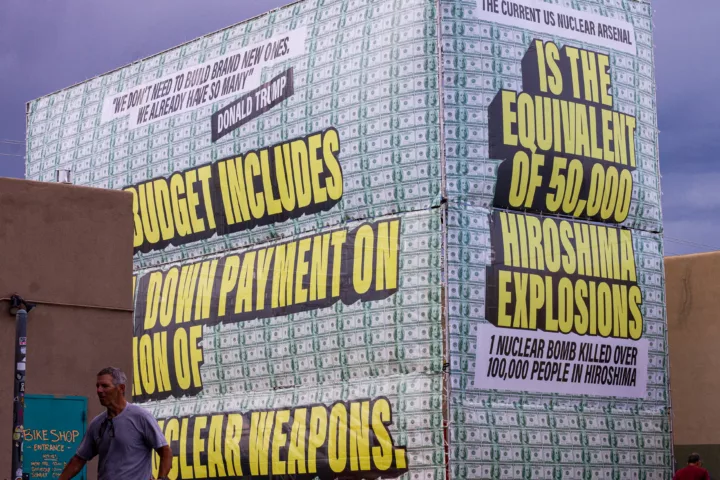For immediate release December 7, 2015
Contacts: Jay Coghlan, jay[at]nukewatch.org
Deadline for Last Cleanup Milestone of LANL Consent Order Passes
NukeWatch Calls for Public Seats at the Table in Negotiations
Santa Fe, NM – Yesterday, December 6, was the deadline for the last compliance milestone in the Consent Order between the New Mexico Environment Department (NMED) and the Department of Energy (DOE) that governs cleanup at the Los Alamos National Laboratory (LANL). Ironically, that last milestone required the submittal of a report by the Lab on how it successfully completed cleanup of Area G, its largest waste dump. Real comprehensive cleanup is decades away at current funding levels. One of the purposes of the 2005 Consent Order was to prod Congress to increase funding for cleanup of 70 years of neglected Cold War contamination at the Lab.
NMED has the final decision on what form cleanup of hazardous wastes takes at LANL. But any revised Consent Order is still off in the future, and the degree of public participation in its formulation yet to be determined by NMED. Meanwhile, LANL plans to “cap and cover” Area G, thereby creating a permanent nuclear waste dump in unlined pits and shafts, with an estimated 200,000 cubic yards of toxic and radioactive wastes buried above the regional groundwater aquifer, 4 miles uphill from the Rio Grande.
Following protracted negotiations and threatened litigation by DOE against NMED, the Environment Department succeeded in getting DOE and the LANL contractor to sign the original Consent Order in March 2005. However, beginning in 2012, NMED signed a “Framework Agreement” with DOE that prioritized the transfer of 3,706 cubic meters of aboveground, monitored “transuranic” (TRU) wastes from nuclear bomb production at Area G to the Waste Isolation Pilot Plant (WIPP) in southern New Mexico.
The stated rationale of this so-called 3706 Campaign was to minimize the risk from wildfire following the 2010 Las Conchas Fire that burned within 3.5 miles of Area G. However, if those TRU wastes were really at risk from wildfire, they would have burned during the 2000 Cerro Grande Fire that came within a half-mile of Area G. The Framework Agreement allowed LANL to discontinue most legacy cleanup to concentrate on TRU shipments that should have already been completed.
Moreover, the 3706 Campaign itself ended in disaster in February 2014 when an improperly treated radioactive waste drum from LANL ruptured at WIPP, contaminating 21 workers and indefinitely closing down that multi-billion dollar facility. Dealing with the 59 similarly treated “suspect” drums still at LANL will use a substantial amount of scarce cleanup funding for at least the next two years. Combined with the need to address a large chromium groundwater plume discovered after the original Consent Order went into effect, cleanup of buried mixed radioactive wastes will remain on the back burner, if ever addressed.
Further, since 2011 LANL has requested and NMED perfunctorily granted more than 150 milestone extensions, thus effectively eviscerating the Consent Order without public comment and consent. Which brings us to today, after the last compliance milestone deadline has expired, with little cleanup actually accomplished since 2012. A new schedule of cleanup is on hold until a revised Consent Order is negotiated.
Previously NMED Secretary Ryan Flynn has said that a draft revised Consent Order would be released for a 60-day public comment period before the end of 2015. But as of mid-November negotiations had not started. More recently Secretary Flynn has said that a draft renewed Consent Order would be released only after the schedule of payments is finalized for a $73 million settlement over WIPP violations. WhileNuclear Watch New Mexico appreciates NMED’s firmness on the WIPP settlements, we would like to see the same amount of zeal applied to enforcing cleanup at LANL through the Consent Order.
NukeWatch strongly believes that much more vigorous public participation steps, including the opportunity for a public hearing, are legally required by the existing Consent Order. Specifically, the March 2005 Consent Order incorporated the full public participation requirements applicable to hazardous waste permits. Federal environmental regulations, which are incorporated into New Mexico state regulations, establish the public participation procedures for various types of permit modifications, including extending final compliance dates. These are deeper levels of public participation than the 60-day public comment period that NMED is currently contemplating. In our view, a 60-day public comment period on a draft Consent Order is tantamount to commenting on a done deal already negotiated between DOE and NMED.
Scott Kovac, Research and Operations Director for Nuclear Watch New Mexico, stated, “The requirements are clear for deep and meaningful public participation in LANL cleanup decisions, including the opportunity for the interested public to have a seat at the negotiating table and the possibility for a public hearing. NMED must make Cold War legacy cleanup a priority at LANL and should start by prioritizing full public participation while negotiating the revised Consent Order.”
Jay Coghlan, NukeWatch Executive Director, added, “Ultimately this is all about the future of cleanup at LANL, which is receiving less federal funding while the nuclear weapons programs that created the mess to begin with are getting more money. We want nothing short of comprehensive cleanup at the Los Alamos Lab. That would be a real win-win for New Mexicans, permanently protecting our water and the environment while creating hundreds of high-paying jobs.
# # #
Nuclear Watch’s letter to Secretary Flynn – on Consent Order public participation requirements.
The existing Consent Order governing cleanup at LANL

